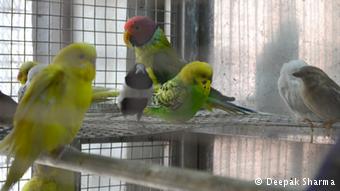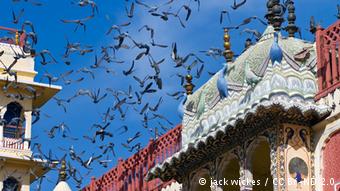Global Ideas
The bird hospital Delhi
India’s crowded and chaotic capital city, is a Paradise for birds, but pollution, malnutrition, and injuries. A unique hospital is the flying city dwellers.

Dr Bhat says that he learned a lot in the treatment of his difficult and charismatic patient.
Anyone who has been to Delhi, will not be lost on the many birds: birds with crimson beaks chattering wildly in the columns of the ancient tombs. Horn, birds and hoopoe flutter through the Park, black kites circles screaming at the sky and plunge down into the urban canyons, majestic peacocks with a high-pitched scream in the Parks and woods finish the day. Owls are everywhere.
Old Delhi, the walled historic old town from the 17th century. Century is a world, quite different than the adjacent capital, with its wide avenues and the political fray. Here there is a thriving bird market-parrots, pigeons, pheasants and budgies. Many of the inhabitants still practise the art of Kaboortabazi, the breeding of pigeons. It is a legacy of the old Mughal rulers. Delhi is without a doubt a place of the bird-fools.
Rarer species can be found in the Okhla bird sanctuary, one of the richest nature reserves of Northern India areas in the alluvial plain of the heavily polluted Yamuna river flows through Delhi. In Winter, the area attracts many water birds like storks, Flamingos and geese. And even in the summer, bird-watchers, partridges, woodcocks, snipe, ducks and crested will be able to see herons.
But experts complain for years a steady decline in bird numbers in and around Delhi. Due to the increasing pollution and urbanisation, the birds lose their natural habitat and their breeding places.
This means a lot of work for Sunil Kumar Bhat, the chief veterinarian at the Charity Birds Hospital. The hospital in a two-storey house in Old Delhi treats sick and injured birds for free.
The Sparrows Doctor

Clashes with fans or kite strings often cause serious injuries in birds
From the outside rather unimpressive, and is home to the house a large number of cages and aviaries, with around 2500 birds, most of the pigeons. Depending on the type and condition they are placed in different hospital wards and waiting for surgery or recover from it. 50 to 60 birds every day in the Hospital “” – from private individuals, welfare organisations, and sometimes even by the police.
“In fact, we take on more birds than we can handle. But what are we supposed to do. I did not bring about the heart to dismiss it,” says Bhat, the local residents call the “Sparrow, doctor”.
About a lack of working can not complain Bhat. Of operations, broken wings and bones, the administration of antibiotics, treatment of wounds and grains diet programs to the regular Rounds.
Risk Factor No. 1: Collisions

Many birds need to be treated for respiratory diseases, especially in the Winter
Recently, one afternoon, had to Bhat and his Team help an injured peacock. Held by an assistant, was the great bird on the table, his right leg is unnaturally bent. “The bone is broken, it was probably from a Bicycle to drive,” says Bhat, while he operates the bird’s leg band. “But in a few weeks, he’ll be better again, and then we will suspend him in a nearby forest.”
Injuries due to collisions are one of the biggest risks for Delhi’s birds. Clashes of fans with rotating ceiling, down stream hanging cables or the cords of the flying dragon, the feathered inhabitants of the town of hurt is often difficult.
A few years ago, the vet reported he treated a Sparrow, with severe burns was flown at a street vendor in a pot full of boiling Oil. “We Packed the bird in ice and treated him for months with painkillers and antibiotics,” says Bhat. “The Sparrow survived. It was a miracle and gave us all the feeling that our work is their use really worth.”

Mohammad Nadeem came to his parrot treat
Many of the patients with dysentery and other digestive problems – a result of malnutrition, and because they eat the unsorted waste, the Delhi’s 18 million inhabitants produce every day. The ever-worsening air and water quality in the city is another big Problem. Respiratory problems are in the Winter very often. “Birds are very sensitive. You need clean air and clean water, so that you are well,” says Bhat. “Just as people are prone to diseases and have similar Suffering.”
Let you free
The birds that do make it to the hospital, the staff is proud of the fact that 80 percent of the animals are healthy again. The organization, which was founded in the 1930s by followers of the Jain Religion, funded exclusively by donations, in the Form of money, grains, fodder, medicines or other supplies.
According to the Tradition of the Jain view, all forms of life as sacred, the hospital all the birds in his care again. This is not always possible. “We encourage people not to buy any birds, because they often do not know how to properly take care of them,” says Bhat. “But of course we can’t take away the birds to their owners that the animals bring to the investigation all over. Therefore, a large part of our work is to create in the people a consciousness, how do you feed your birds correctly, and properly care for them.”

On the hospital roof, there is free for all water and grains
Many of the people who come in with sick birds, seem to be satisfied with the work of the clinic. Mohammed Nadeem is with his two-year-old parrot, which had become, according to his owner, passive and depressed. “I have to get the Doctors here are always good advice,” says Nadeem. “And my bird it was better each Time. This is the most important thing.”
Meatless-Policy
However, some of the ‘No meat’policy of the hospital are skeptical. The Jain are strict vegetarians, therefore, are mainly focused on vegetarian food of the birds. But also some meat-eating birds there are, in this case, an owl with a clipped wing and a few injured eagles, hawks and kites in different cages.
“These birds we can’t reject, but because of the religious setting, we can feed them, nevertheless, no meat,” says Bhat. “And therefore, we give alternative protein sources such as soy, paneer-fresh cheese, or fruit.”
Some of the bird-lovers of the city are not at all in agreement. “The hospital is doing excellent work, but birds of prey to feed them with fruits is a Disaster,” says Akshay Seth, an Amateur ornithologist, with good knowledge of Delhi’s bird world. “The birds of prey have no metabolism that could digest a fruit or Soya. By the food, you will die a slow death. It is as you would feed a lion Grass.”
Seth says, the hospital should cooperate instead with other organizations, which can make for meat eating birds and a sufficient meat supply. This is a proposal that is likely to be found in the Jain-run Hospital with little appeal.
Apart from this, the meat of the war of a doubt that the bird hospital in Old Delhi is a blessing for the bird-population of the city. Dr. Bhat under his busy work day breaks for a break on the roof, where a variety of birds refuel – troughs with medically-treated water and grain feed, before you make it back on the road in the air over the chaotic streets of the city. For Bhat this is also a kind of medicine. “It’s like watching relaxing you,” he says.
